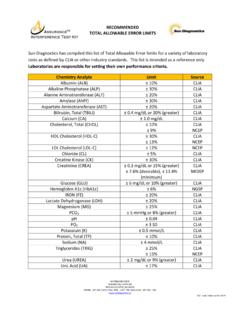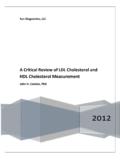Transcription of is not normally performed. Manufacturer’s interference ...
1 1 Assay interference : A Need for Increased understanding and Testing John H. Contois and Rae-Anne Nguyen Sun Diagnostics, LLC New Gloucester, Maine Laboratory Directors assume responsibility for the quality of data that is reported from their laboratories. A recent publication reminds us that the laboratory is likely to see contradictory data when comparing in-house interference data to information reported on the package insert (1). However, the quality of interference testing data provided by the manufacturer is seldom questioned, and, in-house interference testing is not normally performed . manufacturer s interference data were accepted by 95% of laboratories; only 8% of laboratories performed in-house interference studies (2). In March, 2011, a major IVD company issued a recall for glucose reagents because sample hemolysis was causing falsely elevated results.
2 Apparently, changes made to the assay over time resulted in significant interference not seen during initial validation. This raises the question: How often do issues related to interference go unrecognized? While relying on the manufacturer s interference claims is considered sufficient to meet regulatory requirements, this information may not translate to performance in a specific clinical laboratory. The laboratory must implement an effective detection system to identify specimens with clinically important interferents and a specific policy to prevent reporting of inaccurate results. One study reported that of all specimens contained at least one visible interferent; 76% were lipemic, 16% were hemolyzed, and 6% were icteric (3), yet visual inspection of samples alone is not effective.
3 The use of automated, spectrophotometric measurement of bilirubin, hemoglobin, and lipemia (serum indices), along with clearly defined decision rules, is effective (4), but must include an understanding of the relationship between index scale and the impact on each test. It is also important for the laboratory to understand how the indices were determined by the manufacturer: icterus and hemolysis indices are usually correlated with bilirubin and hemoglobin concentrations; lipemia index is typically based on the spectrophotometric response of Intralipid, a synthetic lipid emulsion, and cannot be correlated with the response of human triglyceride-rich lipoproteins. Interestingly, a recent abstract reports that only 38% of laboratories were using automated serum indices for assessment of interference (2).
4 2 Information provided by the manufacturer may not be adequate for the laboratory to gauge the impact that interference will have on their results. Often, the data is reported without defining a significant change or what analyte concentration was tested along with the interferent, and interpretation is often based on an arbitrary 10% rule (5). The experimental design may be vague, such that the user does not have adequate information to make an informed decision about the adequacy of interference testing (5). There are other reasons for a laboratory to consider performing in-house interference testing experiments, such as: verifying the commutability of interference data from the manufacturer to your specific instrument/reagent system; the desire to test interference with at least two levels of analyte, as recommended by CLSI due to potential interdependence of interferent and analyte concentrations, and determining the applicability of data generated from testing that used artificial materials, such as Intralipid , instead of human lipoproteins to test lipemia interference .
5 Common Interferents interference from hemolysis (hemoglobin and /or red blood cell contents), lipemia (triglyceride-rich lipoproteins or turbidity), icterus (unconjugated or conjugated bilirubin), and proteins (albumin and gamma-globulins, paraproteins) are so common with routine chemistry assays, that validation by manufacturers always includes interference testing for these substances. Newer instruments and reagent formulations are better able to limit the effect of common interferents; sample blanking, bichromatic measurements, and additives to inhibit interferents have all been effective to a certain degree, but problems have not been eliminated. Unfortunately, we cannot develop universal rules regarding interference , as instruments and reagent systems can vary widely in the response to specific interferents (6, 7).
6 Some investigators have developed mathematic formula for the correction of interference , but this is generally not a good idea. The best approach is to understand the limitations of the assay you use in your laboratory, and not report results that are inaccurate to a degree that they will impact clinical interpretation. Hemolysis Hemolysis occurs in about 3% of all specimens received in the laboratory and accounts for 40% to 70% of all unsuitable specimens (8). Dimeski describes four mechanisms for interference from hemolysis: additive, spectral, chemical, and dilutional (9). interference may be due to hemoglobin or to other red 3 cell constituents that are released into plasma or serum. These substances can directly or indirectly interfere with a number of assays, including ALT, AST, creatinine, CK, iron, LDH, lipase, magnesium, phosphorus, potassium, urea, albumin, ALP, chloride, GGT and sodium (10-12).
7 Differentiating between in vivo and in vitro hemolysis is vitally important to patient management. It is sometimes possible to differentiate between the two biochemically. Free hemoglobin in the circulation binds to haptoglobin and the complex is rapidly cleared. Therefore, a decrease in serum haptoglobin is consistent with in vivo hemolysis. Increased bilirubin and reticulocyte counts are also characteristic of in vivo hemolysis. The bilirubin is derived from the breakdown of heme, while the presence of reticulocytes indicates the physiological response to anemia. Another clue differentiating in vitro and in vivo hemolysis is the concentration of intracellular contents: in vitro hemolysis is typically characterized by an increase in cellular components such as K, LDH, and AST, which would be quickly normalized during in vivo hemolysis.
8 Given the clinical significance of hemolysis, the cause of hemolysis should be investigated and documented. Procedures for handling and reporting hemolyzed specimens should be available, including appropriate rejection criteria. As a rule of thumb, when most or all specimens from a patient are hemolyzed, in vivo hemolysis should be suspected and reported to the physician. When intermittent specimens are hemolyzed, it is likely to be preanalytical, in vitro hemolysis. In vivo hemolysis is relatively rare, accounting for only about 3% of all hemolyzed specimens (10), which is all the more reason to be vigilant. Hemoglobin, which absorbs light strongly at around 550 nm, can cause an apparent increased analyte concentration when monitored near this wavelength. Bichromatic readings and sample blanking will minimize interference ; however, the high background absorbance may still be problematic (13).
9 Hemoglobin may also have pseudo peroxidase activity which may interfere with bilirubin measurement by diazonium methods (3). Artifactual release of red cell constituents will have obvious effects on the accuracy of serum concentrations, especially K, Mg, P, LDH, AST and ALT (10); AST activity is approximately 40-fold higher in erythrocytes than in plasma, so that even slight hemolysis can alter results (10). Potassium is typically 25 times more concentrated in red blood cells than in plasma. Adenylate kinase released from red cells can increase creatine kinase (CK) activity (10), although the addition of AMP or other analogs can inhibit adenylate kinase (11). Although most phosphate in red blood cells is organic, it can stimulate the release of inorganic phosphate in serum (6).
10 It is inappropriate to use hemoglobin to assess interference from hemolysis because only the direct effect of hemoglobin is evaluated. The effect of dilution and other red cell components should be considered, as well. CLSI therefore recommends interference testing by spiking hemolysate into a non-hemolyzed serum pool (14). 4 Various techniques have been used to reduce or correct for hemolysis interference . Deproteinization by ultrafiltration or precipitation can remove hemoglobin but cannot correct for the release of intracellular contents. Sample blanking and bichromatic measurement will decrease the absorbance effect of hemoglobin but, again, will not correct for the release of intracellular contents. It is critically important that the laboratory have a clear understanding of the effect of hemolysis on each laboratory test and clearly know when a test result cannot be accurately reported.


